Zoom In on Galaxy M87
This movie zooms into galaxy M87 using real visible light, X-ray and radio pictures of the galaxy, its jet of high-speed particles, and the shadow of its central black hole.
This movie is available both with and without on-screen text.
Credit: NASA's Goddard Space Flight Center
Music: "Tension Underlying" from Universal Production Music
Credits
Please give credit for this item to:
NASA's Goddard Space Flight Center
-
Producer
- Chris Smith (USRA)
-
Animator
- Chris Smith (USRA)
-
Science writer
- Francis Reddy (University of Maryland College Park)
Series
This page can be found in the following series:Release date
This page was originally published on Tuesday, September 24, 2019.
This page was last updated on Wednesday, May 3, 2023 at 1:45 PM EDT.

